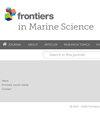半日潮流对两周悬沙响应的准调和分析
IF 3
2区 生物学
Q1 MARINE & FRESHWATER BIOLOGY
引用次数: 0
摘要
悬沙浓度(SSC)是海洋工程中的一个重要问题。通过考虑SSC的两周特性,可以研究沉积物的运动特征。然而,这种考虑目前缺乏精确的数学表示。方法建立基于再悬浮、沉积、平流的SSC预测数学模型,对M2、S2、O1、K1、M4和MS4潮汐主导的沿海地区SSC两周动态进行数学解释。模型将SSC分解为35个拟调和项和2个两周周期项。结果将该模型应用于中国渤海、黄海和东海5个观测点,验证了该模型能够再现SSC的两周变化。结果表明:主双周SSC项由M2和S2潮流共同作用产生,潮汐频率为1.0159°/h,等于两个偏潮频率之差;重悬性质仅影响两周SSC项的振幅,而不影响相位。沉积特性对振幅和相均有影响。准调和分析表明,在某些非线性潮汐相互作用较强的浅海区域,M4潮高程幅值会影响平均SSC,而MS4潮高程幅值会影响两周SSC幅值。由于简化模型是建立在一定的假设基础上的,所以准调和解析解的适用条件包括近似的往复流型,潮差明显小于水深。我们的结果为悬沙的两周演化提供了一个数学解。本文章由计算机程序翻译,如有差异,请以英文原文为准。
Quasi-harmonic analysis of fortnightly suspended sediment response to semi-diurnal tidal currents
IntroductionThe suspended sediment concentration (SSC) is an important consideration in marine engineering. Sediment movement characteristics can be studied by considering the fortnightly behavior of SSC. However, this consideration currently lacks accurate mathematical representation.MethodIn this study, a computationally efficient mathematical model capable of providing analytical solutions for predicting SSC based on resuspension, deposition, and advection was developed to further investigate the mathematical interpretation of fortnightly SSC behavior in coastal areas dominated by M2, S2, O1, K1, M4 and MS4 tides. The model decomposed the SSC into 35 quasi-harmonic terms as well as two terms with fortnightly period.ResultThe model was applied at five observation sites in the Bohai Sea, Yellow Sea and East China Sea, China, and validated to be able to reproduce the fortnightly variation of SSC. The results show that the primary fortnightly SSC term was generated by the combined action of M2 and S2 tidal currents and had a tidal frequency of 1.0159 °/h, which was equal to the difference between the frequencies of the two partial tides.DiscussionThe resuspension properties only affected the amplitude of the fortnightly SSC term but did not affect the phase. The deposition properties affected both amplitude and phase. The quasi-harmonic analysis indicates that in certain shallow sea areas with strong nonlinear tidal interactions, the amplitude of the M4 tidal elevation can influence the mean SSC, while the amplitude of the MS4 tidal elevation can affect the fortnightly SSC amplitude. As the simplified model is based on certain assumptions, the application conditions of the quasi-harmonic analytical solution include an approximate reciprocating flow pattern, a tidal range significantly smaller than the water depth. Our results provide a mathematical solution for the fortnightly evolution of suspended sediment.
求助全文
通过发布文献求助,成功后即可免费获取论文全文。
去求助
来源期刊

Frontiers in Marine Science
Agricultural and Biological Sciences-Aquatic Science
CiteScore
5.10
自引率
16.20%
发文量
2443
审稿时长
14 weeks
期刊介绍:
Frontiers in Marine Science publishes rigorously peer-reviewed research that advances our understanding of all aspects of the environment, biology, ecosystem functioning and human interactions with the oceans. Field Chief Editor Carlos M. Duarte at King Abdullah University of Science and Technology Thuwal is supported by an outstanding Editorial Board of international researchers. This multidisciplinary open-access journal is at the forefront of disseminating and communicating scientific knowledge and impactful discoveries to researchers, academics, policy makers and the public worldwide.
With the human population predicted to reach 9 billion people by 2050, it is clear that traditional land resources will not suffice to meet the demand for food or energy, required to support high-quality livelihoods. As a result, the oceans are emerging as a source of untapped assets, with new innovative industries, such as aquaculture, marine biotechnology, marine energy and deep-sea mining growing rapidly under a new era characterized by rapid growth of a blue, ocean-based economy. The sustainability of the blue economy is closely dependent on our knowledge about how to mitigate the impacts of the multiple pressures on the ocean ecosystem associated with the increased scale and diversification of industry operations in the ocean and global human pressures on the environment. Therefore, Frontiers in Marine Science particularly welcomes the communication of research outcomes addressing ocean-based solutions for the emerging challenges, including improved forecasting and observational capacities, understanding biodiversity and ecosystem problems, locally and globally, effective management strategies to maintain ocean health, and an improved capacity to sustainably derive resources from the oceans.
 求助内容:
求助内容: 应助结果提醒方式:
应助结果提醒方式:


